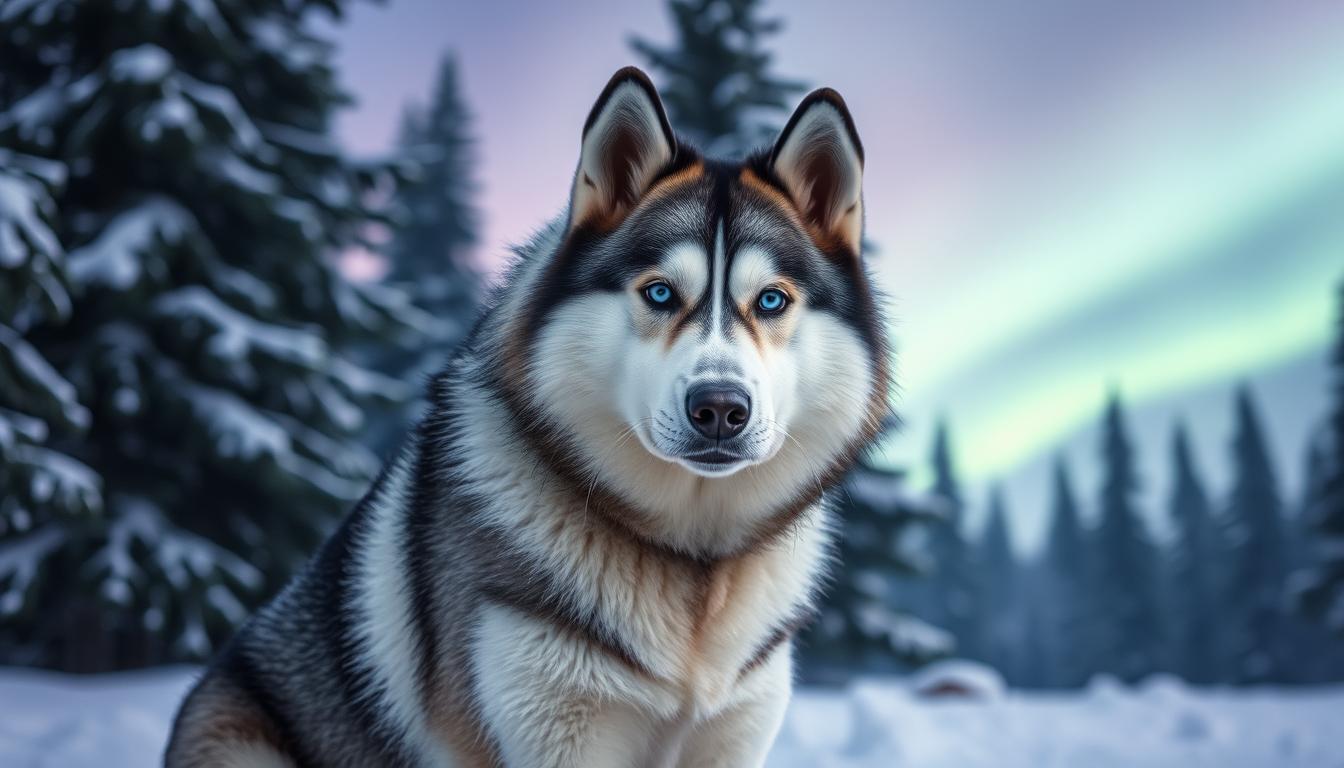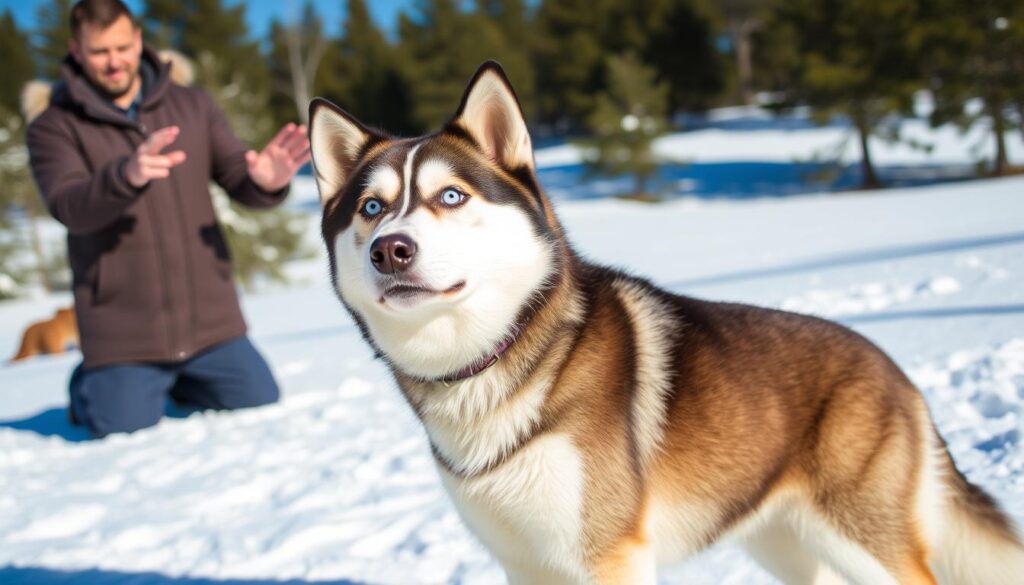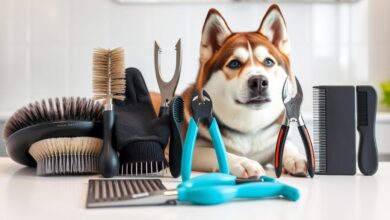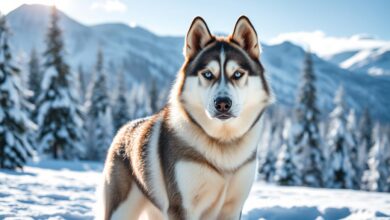Purebred Siberian Husky: A Majestic Arctic Everyday Companion

Imagine a breed that captures the wild beauty of the Arctic and becomes a loving family pet. Welcome to the world of the purebred Siberian Husky. This amazing dog, with its stunning looks and lively spirit, has won the hearts of many. If you’re thinking of getting a Siberian Husky or just want to know more, this guide is for you. It covers everything you need to know about this incredible breed.
Key Takeaways
- Siberian Huskies are a purebred dog breed with origins in the Arctic region of Siberia.
- These majestic canines are known for their striking appearances, including their thick, double-layered coats and distinctive facial markings.
- Siberian Huskies are friendly, affectionate, and highly energetic, making them well-suited for active families.
- Proper grooming and shedding management are essential for maintaining a Siberian Husky’s coat and keeping their living space clean.
- Siberian Huskies require a balanced diet and regular exercise to thrive, and they are prone to certain health conditions that require vigilant veterinary care.
The Majestic Purebred Siberian Husky
The Siberian Husky is a captivating breed from the Arctic regions of Siberia. They have won the hearts of dog lovers everywhere. Their striking looks, robust build, and wolf-like features make them special.
Siberian Husky Breed Origins
The Siberian Husky breed comes from the remote Siberian region of Russia. The Chukchi people developed them as sled dogs and companions. These dogs were vital for survival, helping to transport goods and people in harsh landscapes.
Their endurance, strength, and adaptability to the Arctic climate were key. These traits helped them evolve into a distinct breed.
Distinguishing Traits of Purebred Huskies
- Striking Appearance: Siberian Huskies have a thick, double-layered coat in various colors and patterns, like black, white, grey, and copper.
- Wolf-like Features: They have pointed ears, almond-shaped eyes, and a wedge-shaped head. This gives them a regal, mystical presence.
- Muscular Build: Huskies are muscular and well-proportioned. They have a moderate size and strong, athletic build. This allows them to excel in activities like running, hiking, and sled-pulling.
- Adaptability: Huskies are highly adaptable. They can thrive in many climates and environments, from the Arctic to modern homes.
The purebred Siberian Husky’s captivating appearance, rich heritage, and adaptability make them remarkable. They continue to enchant dog enthusiasts worldwide.
Siberian Husky Temperament: A Wolf in Dog’s Clothing
Siberian huskies are often called “wolf in dog’s clothing” because of their unique temperament. They are full of energy and smart, with a friendly side and a strong will. Knowing about their temperament is key for those thinking of getting one.
Friendly and Affectionate Nature
Siberian huskies are known for being friendly and loving. They love being around people and can form strong bonds. They are gentle with kids and get along well with other pets, making them great for families.
They are outgoing and love to interact, which makes them popular as loyal and loving pets.
High Energy and Exercise Requirements
Siberian huskies have lots of energy and need a lot of exercise. They were bred to work and love to run and explore. Without enough physical activity, they can get destructive and have behavioral problems.
People thinking of getting a husky need to be ready to spend a lot of time exercising them. Understanding their temperament helps create a happy and fulfilling life together.
Caring for Your Purebred Siberian Husky
Having a purebred Siberian husky is rewarding but comes with big responsibilities. They need careful grooming and training to stay healthy. Let’s explore how to care for your furry friend.
Grooming and Shedding Concerns
Siberian huskies have thick coats for the Arctic. But, they shed a lot, especially in spring and fall. Regular grooming is key to keep their coat shiny. Brush them often to remove loose hair and bathe them sparingly to protect their coat.
Dietary Needs and Feeding Guidelines
Huskies are full of energy and need a good diet. Choose a high-quality dog food for large breeds. Adjust the food amount based on their age, activity, and needs. Always give fresh water and avoid table scraps to prevent stomach problems. Talk to your vet to find the right food for your husky.
| Grooming Tip | Feeding Guideline |
|---|---|
| Brush your husky’s coat 2-3 times per week | Feed a high-quality, large breed dog food |
| Bathe only when necessary to avoid stripping natural oils | Adjust portion sizes based on age, activity level, and individual needs |
| Trim nails regularly to prevent overgrowth | Provide plenty of fresh water and avoid table scraps |
By following these siberian husky grooming and feeding guidelines, you can keep your husky healthy and happy. Remember, being a responsible husky owner is crucial for their well-being.
Training Your Siberian Husky Companion
Owning a Siberian husky means you must commit to training them well. These smart and lively dogs need mental challenges and steady guidance. Good husky training helps you bond with your dog and makes them a pleasure to be around.
Siberian huskies look like wolves and act a bit like them too. This can make training tough if you’re not ready. But, with the right husky training guides and methods, you can turn their energy into good habits.
Positive Reinforcement is Key
For siberian husky training, positive rewards work best. Dogs like praise, treats, and rewards for good behavior, not punishment. This way, you build trust and make your husky want to learn more.
- Begin with simple commands like “sit,” “stay,” and “come” to lay a solid obedience base.
- Make training fun and interactive to keep your husky interested and active.
- Remember, consistent practice and patience are key to improving your husky’s skills over time.
Training a Siberian husky takes time and effort, but the joy of having a loyal, well-behaved friend is priceless. With the right husky training approach, your dog will become a beloved family member.

Purebred Siberian Husky Health Considerations
Siberian Huskies are generally healthy dogs. But, like any breed, they can face certain health issues. It’s important to know these husky health concerns and take steps to prevent them. This ensures your purebred Siberian husky stays well.
Common Health Issues in Huskies
Some common health issues in Siberian Huskies include:
- Hip and elbow dysplasia, which can lead to joint pain and mobility issues
- Eye conditions, such as cataracts and progressive retinal atrophy
- Skin allergies and sensitivities
- Hypothyroidism, a thyroid disorder that can affect energy levels and weight
Preventive Care and Veterinary Checkups
To keep your Siberian husky healthy, provide preventive care and schedule vet visits. This includes:
- Routine vaccinations to protect against common infectious diseases
- Annual or biannual wellness exams to detect any health issues early
- Monitoring for signs of joint, eye, or skin problems and addressing them promptly
- Feeding a high-quality, husky-appropriate diet and maintaining a healthy weight
By being proactive and vigilant about your Siberian husky’s health, you can ensure they live a long, happy life.
| Common Siberian Husky Health Issues | Preventive Measures |
|---|---|
| Hip and elbow dysplasia | Regular veterinary checkups, joint supplements, maintaining a healthy weight |
| Eye conditions (cataracts, progressive retinal atrophy) | Routine eye exams, early treatment, avoiding breeding affected dogs |
| Skin allergies and sensitivities | Identifying and avoiding triggers, using hypoallergenic products, managing symptoms |
| Hypothyroidism | Regular thyroid testing, medication if necessary, monitoring weight and energy levels |
“Preventive care is the key to maintaining the health and well-being of any dog, and Siberian Huskies are no exception. By staying proactive and addressing potential issues early, you can help your beloved companion thrive.”
Siberian Husky Coat Colors and Markings
Siberian Huskies are known for their stunning coat colors. They come in a wide range of husky colors, from classic black and white to rare solid colors and unique patterns. Learning about siberian husky colors and husky coat colors is really interesting.
One of the most striking features of Siberian Huskies is their blue-eyed look. This eye color is a key trait of the breed, making them even more captivating. Not all Huskies have blue eyes, but they are highly sought after.
Siberian Huskies also have a variety of husky coat colors and markings. You’ll see colors like black, white, gray, and copper. Some even have unique patterns, like the “Agouti” coloration, where each hair has bands of color.
- Classic black and white
- Solid colors: black, white, gray, copper
- Unique patterns: Agouti, Sable, Brindle
- Distinctive blue eyes
The variety of siberian husky colors and markings shows the breed’s rich heritage and genetic diversity. Whether you love the classic black and white or the rarer colors and patterns, Siberian Huskies have a wide range of coat options.

Finding a Reputable Siberian Husky Breeder
Adding a Siberian Husky to your family is a big decision. These dogs, with their wolf-like looks and sled dog background, need special care. Choosing a good breeder means you get a healthy, friendly dog.
Importance of Responsible Breeding
Good Siberian Husky breeders focus on their dogs’ health and happiness. They follow ethical breeding to keep the breed’s unique traits and avoid health problems. This way, you know your new pet will be happy and loving.
Evaluating Breeders and Bloodlines
When looking for a Siberian Husky breeder, find ones who are open about their breeding. They should share the health and family history of their dogs. Look for breeders who:
- Join Siberian Husky clubs and events
- Value a dog’s temperament and social skills
- Do health checks and genetic tests
- Guarantee the dog’s health and support it for life
- Choose breeding pairs carefully to keep the breed true
By doing your homework, you can find a breeder who cares deeply about their dogs. This sets your dog up for a happy life with you.
| Responsible Siberian Husky Breeders | Irresponsible Siberian Husky Breeders |
|---|---|
|
|
Rescuing and Adopting Purebred Siberian Huskies
Welcoming a purebred Siberian Husky into your home can be a rewarding experience. Rescue organizations work hard to help these majestic Arctic dogs find new homes. They give huskies a second chance at a happy life.
Adopting a Siberian Husky from a reputable rescue saves a life and brings a loyal friend into your home. These dogs often have unique personalities and stories. They may need time to adjust, but their love and loyalty are worth it.
Before adopting a Siberian Husky, research local rescue groups and attend adoption events. Make sure you can provide a loving and secure home. Rescuing a husky can be incredibly rewarding for both the dog and your family.


